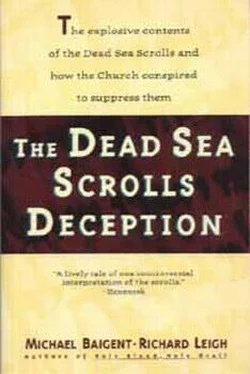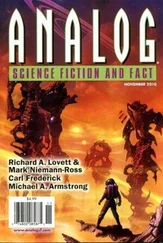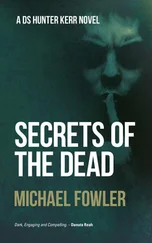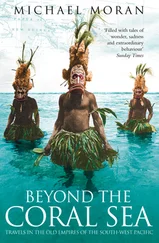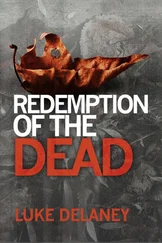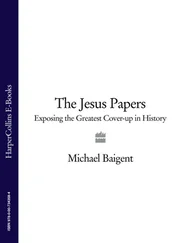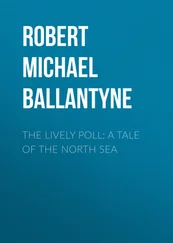How have the members of the international team responded to such damning condemnation? Of the original international team assembled in 1953, only three at present remain alive. Joseph Milik, who has since left the priesthood, maintains, as we have seen, the life of an ‘elusive’ recluse in Paris. Professors John Strugnell and Frank Cross were at Harvard University Divinity School. Of these, Professor Cross proved the most accessible and allowed himself to be questioned about the delays in publication. In an interview with the New York Times, he admitted that progress had ‘generally been slow’ and offered two explanations. Most members of the team, he said, were engaged in full-time teaching and could get to Jerusalem to work on the material only during summer holidays. And the scrolls that have not yet been published, he added, are so fragmented that it is difficult to fit them together, much less translate them. 22‘It’s the world’s most fantastic jig-saw puzzle,’ he remarked on another occasion. 23
It would, of course, be rash to underestimate the complexity of the work in which Cross and his colleagues were engaged. The myriad fragments of Qumran texts do indeed constitute a daunting jigsaw puzzle. Nevertheless, Cross’s explanations are not altogether convincing. It is certainly true that members of the international team are active in teaching and have only limited time to spend in Jerusalem; but Cross did not mention that most of the work now being done on the scrolls is done with photographs, which do not require the researcher to travel anywhere. In fact, the state of photography at present often makes it easier, and more reliable, to deal with photographs than with original parchments. As for the complexity of the jigsaw, Cross himself contradicted his own argument. As early as 1958, he wrote that most of the scroll fragments then in the team’s hands had already been identified — had been identified, in fact, by the summer of 1956. 24According to John Allegro, writing in 1964, assembly and identification of all Cave 4 material — the most copious corpus — was ‘nearly complete’ by 1960/61. 25Nor was the task of identifying material always as difficult as Cross might lead one to believe. In a letter to John Allegro, dated 13 December 1955, Strugnell wrote that £3000 worth of Cave 4 material had just been purchased (with Vatican funds) and identified in one afternoon. 26 Complete photographs of the material, he added, would require no more than a week.
Even before he breached the consensus of the international team, Allegro was anxious to speed things up and sceptical of the various reasons proffered for not doing so. But was it merely as a sop that de Vaux wrote to him on 22 March 1959 that all the Qumran texts would be published, and Discoveries in the Judaean Desert complete, by the middle of 1962, the date scheduled for StrugnelFs concluding volume? In the same letter, de Vaux stated that work on the original texts would be finished by June 1960, after which they would be turned over to the various institutions that had paid for them. Today, more than thirty years after de Vaux’s letter, survivors of his team and its new members still cling to the scrolls in their possession, insisting on the need for continued research. And, it is worth repeating, what has been voluntarily released is, for the most part, of least importance.
The Qumran texts are generally classified under two rubrics. On the one hand, there is a corpus of early copies of biblical texts, some with slightly variant readings. These are referred to as ‘biblical material’. On the other, there is a corpus of non-biblical material consisting for the most part of documents never seen before, which can be labelled ‘sectarian material’. Most outsiders, needless to say, instinctively assume the ‘biblical material’ to be of the greater interest and consequence — the simple word ‘biblical’ triggers associations in the mind which lead automatically to such a supposition. To our knowledge, Eisenman was the first to detect, and certainly the first to emphasise, the sophistry involved in this. For the ‘biblical material’ is perfectly innocuous and uncon-troversial, containing no revelations of any kind. It consists of little more than copies of books from the Old Testament, more or less the same as those already in print or with only minor alterations. There is nothing radically new here. In reality, the most significant texts comprise not the ‘biblical’ but the ‘sectarian’ literature. It is these texts — rules, biblical commentaries, theological, astrological and messianic treatises — that pertain to the ‘sect’ alleged to have resided at Qumran and to their teachings. To label this material ‘sectarian’ is effectively and skilfully to defuse interest in it. Thus, it is portrayed as the idiosyncratic doctrine of a fringe and maverick ‘cult’, a small, highly unrepresentative congregation divorced from, and wholly peripheral to, the supposed mainstream of Judaism and early Christianity, the phenomena to which it is in fact most pertinent. Outsiders are thus manipulated into accepting the consensus — that the Qumran community were so-called Essenes and that the Essenes, while interesting as a marginal development, have no real bearing on broader issues. The reality, as we shall see, is very different, and the perfunctorily dismissed ‘sectarian’ texts will prove to contain material of an explosive nature indeed.
3. The Scandal of the Scrolls
Ironically enough, it was not a biblical scholar, not an expert in the field, but an outsider who first detected something suspect in the international team’s position. The outsider was the distinguished American literary and cultural critic, Edmund Wilson, whom most university students in Britain and the States will have encountered through his work in fields far removed from Qumran and 1st-century Palestine. He is known for his own fiction — for I Thought of Daisy and, particularly, Memoirs of Hecate County. He is known as the author of Axel’s Castle, an original and pioneering study of the influence of French symbolism on 20th-century literature. He is known for To the Finland Station, an account of Lenin’s machinations and the Bolshevik hijacking of the Russian Revolution. And he is known for the grotesque, highly publicised literary feud he precipitated with his former friend, Vladimir Nabokov, by presuming to challenge Nabokov’s translation of Pushkin’s Evgeny Onegin.
As his controversy with Nabokov demonstrated, Wilson had no compunction about venturing into waters beyond his officially acknowledged expertise. But perhaps it was just such recklessness that Qumran research required — the perspective of an outsider, a man capable of establishing some kind of overview. In any case, Wilson, in 1955, wrote a lengthy article for the New Yorker on the Dead Sea Scrolls — an article which, for the first time, made the scrolls a ‘household phrase’ and generated interest in them from the general public. In the same year, Wilson expanded his article and published it as a book, The Scrolls from the Dead Sea. Fourteen years later, in 1969, this text was expanded again, to encompass new material, and was reissued at virtually twice its former length. To this day, it remains one of the basic and most popular investigative works on the Qumran scrolls by an outsider. But even if Wilson was an outsider in the realm of biblical scholarship, he was certainly no mere amateur or dabbler; not even de Vaux’s international team could impugn his integrity or ‘high seriousness’. Wilson was thus able, on behalf of the literate public, to call them in some sense to account.
As early as 1955, Wilson detected a desire on the part of the ‘experts’ to distance the Qumran scrolls from both Judaism and Christianity. The ‘experts’, it seemed to him, were protesting rather too vehemently, and this aroused his suspicions:
Читать дальше
